Post by NFA on Apr 14, 2024 9:42:10 GMT 8
Even with recent temperatures, which are a temporary anomaly, not the new normal, cold is a bigger problem than heat and fossil fuels keep us safer from both.
by Alex Epstein Apr 11, 2024
Myth: Recent, unusually warm temperatures show that fossil fuels are making our climate more and more dangerous.
Truth: Even with recent temperatures, which are a temporary anomaly, not the new normal, cold is a bigger problem than heat and fossil fuels keep us safer from both.
Truth: Even with recent temperatures, which are a temporary anomaly, not the new normal, cold is a bigger problem than heat and fossil fuels keep us safer from both.

Leading outlets are portraying the recent streak of warmer-than-expected months as ominous and deadly, and offering anti-fossil-fuel policies as a solution.
- In reality, cold is a far bigger problem than heat—and anti-fossil-fuel policies will make us more endangered by both.1
- In reality, cold is a far bigger problem than heat—and anti-fossil-fuel policies will make us more endangered by both.1

- Anyone commentating responsibly on warm temperatures must acknowledge 4 facts:
1. Cold-related deaths > heat-related deaths
2. Earth is warming slowly, and less in warm places
3. Fossil fuels make us safer from dangerous temperatures
4. Anti-fossil-fuel policies increase danger from cold and heat
1. Cold-related deaths > heat-related deaths
2. Earth is warming slowly, and less in warm places
3. Fossil fuels make us safer from dangerous temperatures
4. Anti-fossil-fuel policies increase danger from cold and heat
1. Cold-related deaths > heat-related deaths
When our leaders discuss the warming of the planet, they treat warming as obviously bad. But while they portray the planet as already “too hot,” the fact is that far more human beings die of cold than of heat.
When our leaders discuss the warming of the planet, they treat warming as obviously bad. But while they portray the planet as already “too hot,” the fact is that far more human beings die of cold than of heat.
Study after study has found that deaths from cold outnumber deaths from heat by 5-15 times. On every continent cold is more dangerous than heat. Even in many countries we think of as especially hot, such as India, cold-related deaths significantly exceed heat-related deaths.2

The fact that far more human beings die of cold than of heat means that for the foreseeable future, even without accounting for the heating and cooling benefits of fossil fuels, fossil-fueled global warming will save more lives from cold than it will take from heat.3
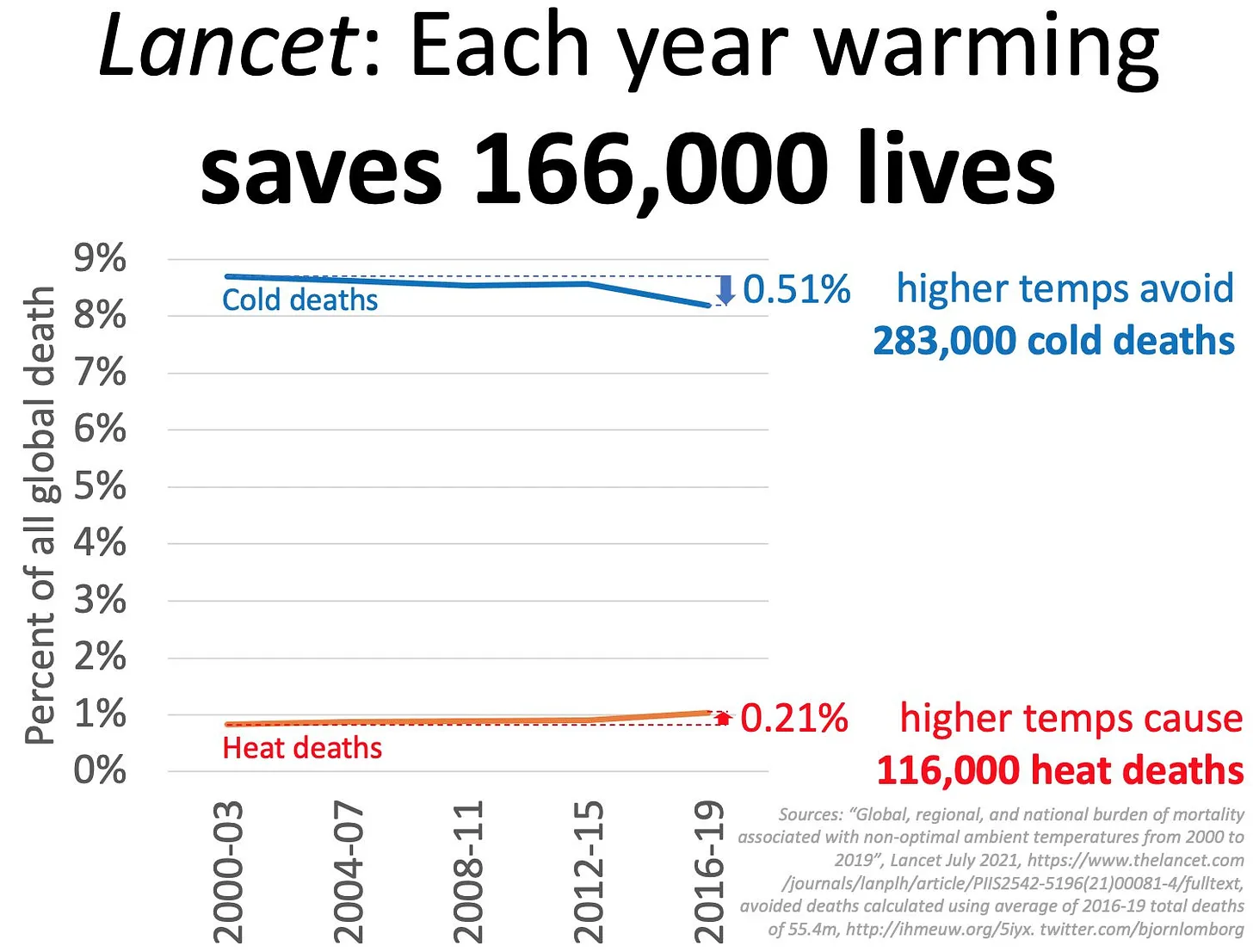
Every story about warming and human mortality should obviously mention that deaths from cold are the biggest source of temperature-related mortality.
But almost no story about warming mentions this!
This level of ignorance and/or dishonesty cannot be tolerated.
Much of the medical community has been particularly shameful in treating warming as catastrophic.
Observe how the prestigious journal The Lancet drastically exaggerated the threat of heat death by making each heat death show up 5 times larger than each cold death on this bar chart!4
But almost no story about warming mentions this!
This level of ignorance and/or dishonesty cannot be tolerated.
Much of the medical community has been particularly shameful in treating warming as catastrophic.
Observe how the prestigious journal The Lancet drastically exaggerated the threat of heat death by making each heat death show up 5 times larger than each cold death on this bar chart!4
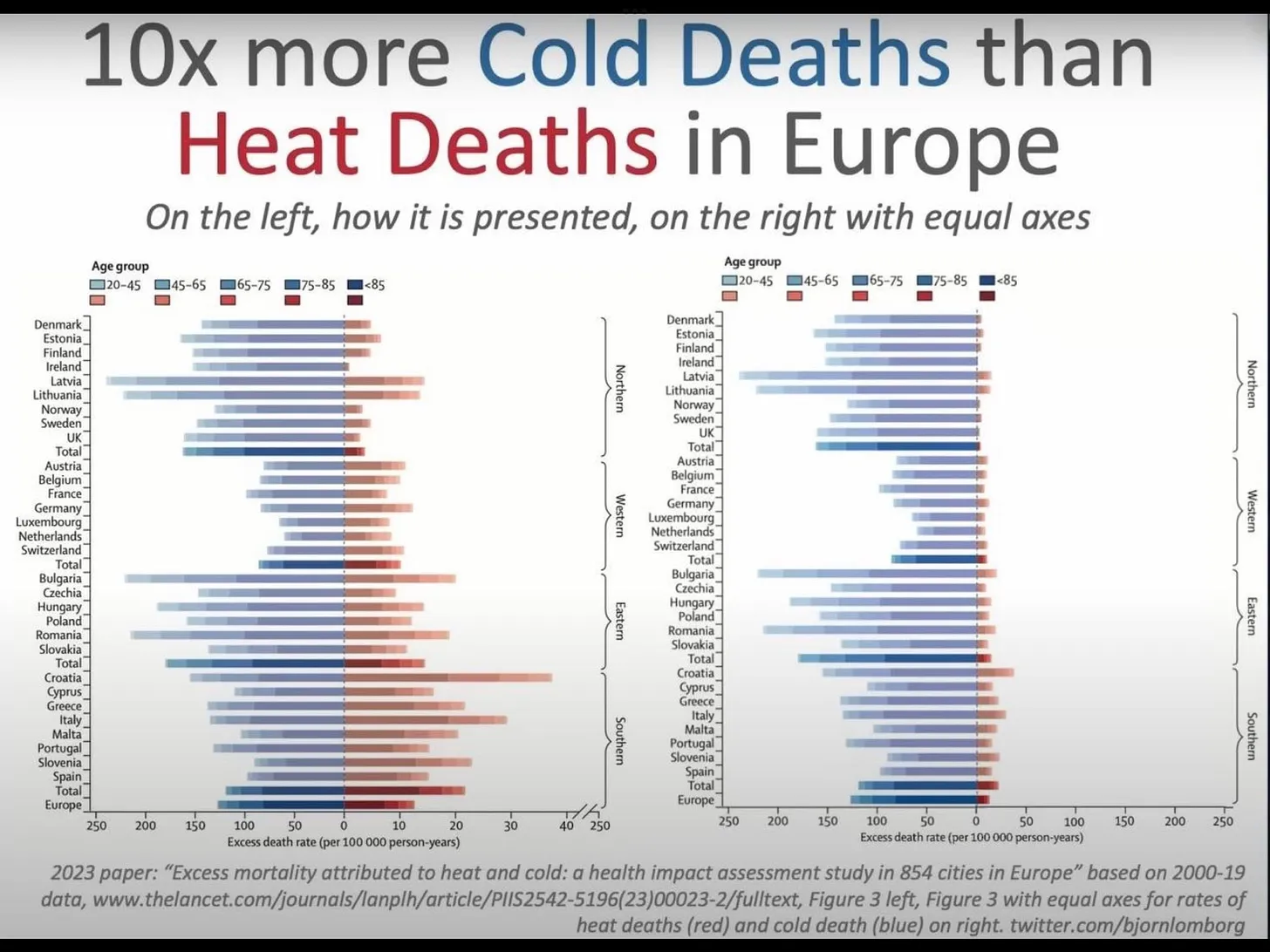
2. Earth is warming slowly—and less in warm places
So far we’ve had ~1°C of warming from a cold starting point in Earth's history 150 years ago. And future warming will be limited by the diminishing nature of the greenhouse effect—as well as being concentrated in colder places.5
If we remember that cold kills more than heat, and we compare the ~1° C average warming that has occurred over the last 150 years with the wide range of temperatures we deal with every day, month, and year, we will not be scared at all.
So climate catastrophists use deceptions to scare us.6
So far we’ve had ~1°C of warming from a cold starting point in Earth's history 150 years ago. And future warming will be limited by the diminishing nature of the greenhouse effect—as well as being concentrated in colder places.5
If we remember that cold kills more than heat, and we compare the ~1° C average warming that has occurred over the last 150 years with the wide range of temperatures we deal with every day, month, and year, we will not be scared at all.
So climate catastrophists use deceptions to scare us.6
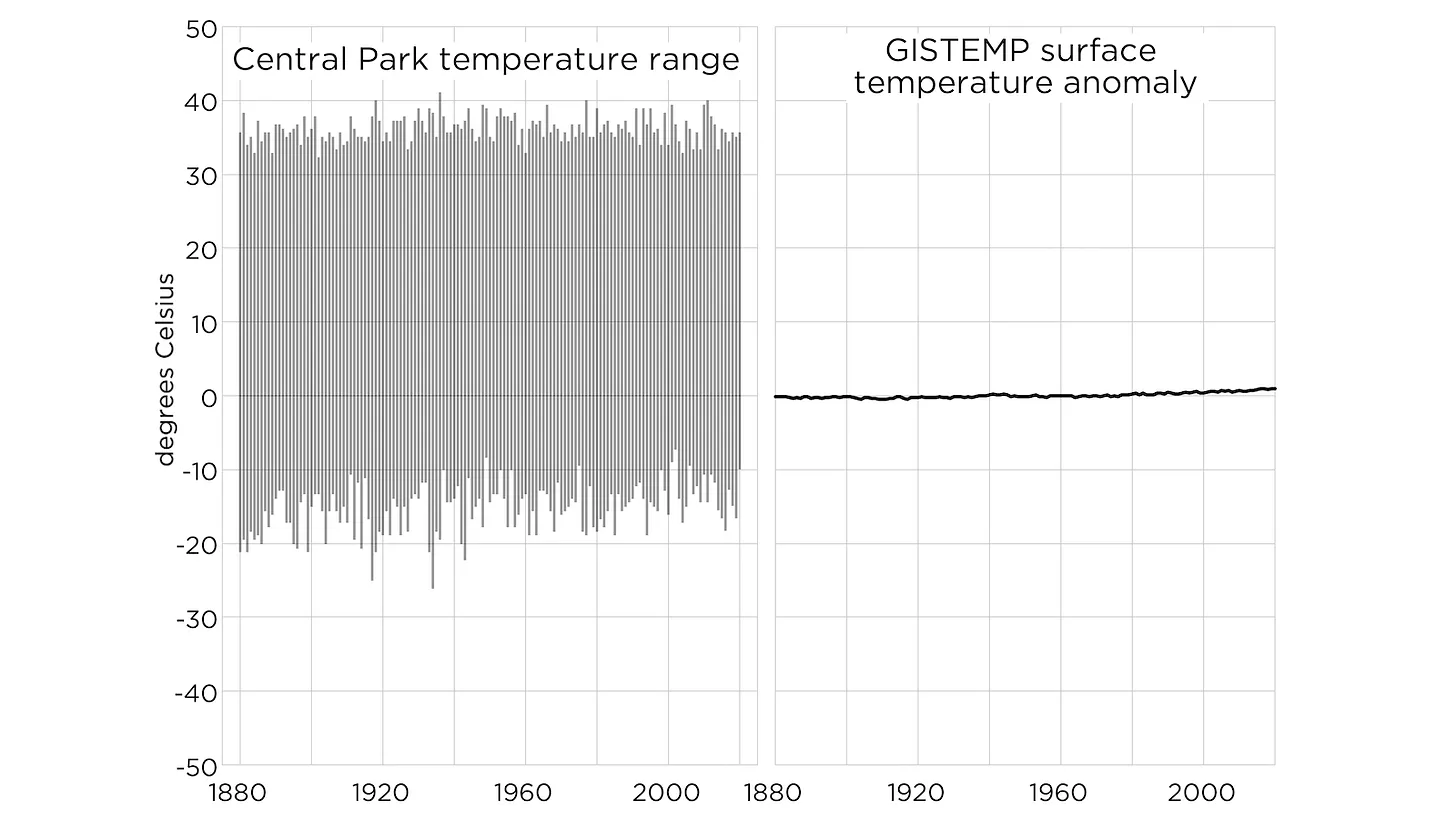
The “treating El Niño warming as global warming” deception
An important contributor to recent temperatures is a shift in the El Niño-Southern Oscillation, from a prolonged La Niña configuration to strong El Niño conditions.
This is a temporary phenomenon, not a climate trend.7
An important contributor to recent temperatures is a shift in the El Niño-Southern Oscillation, from a prolonged La Niña configuration to strong El Niño conditions.
This is a temporary phenomenon, not a climate trend.7


Factors like the massive Hunga Tonga volcanic eruption in late 2021 to early 2022 might have amplified recent warming in the short term by temporarily increasing atmospheric water vapor—a strong greenhouse gas—by about 10%.8

Whatever the exact combination of factors leading to the recent unusually warm temperatures, they are, by everything currently known about climate science, a temporary phenomenon apart from the slow, long-term warming contributed to by human greenhouse gas emissions.
The “compressing the Y-axis” deception
To make the slow warming we have experienced look scary, climate catastrophists like to show warming, not on a human temperature scale but on a compressed Y-axis where 1°C is huge. This is like measuring weight gain on a scale where 1 pound is huge.9
The “compressing the Y-axis” deception
To make the slow warming we have experienced look scary, climate catastrophists like to show warming, not on a human temperature scale but on a compressed Y-axis where 1°C is huge. This is like measuring weight gain on a scale where 1 pound is huge.9
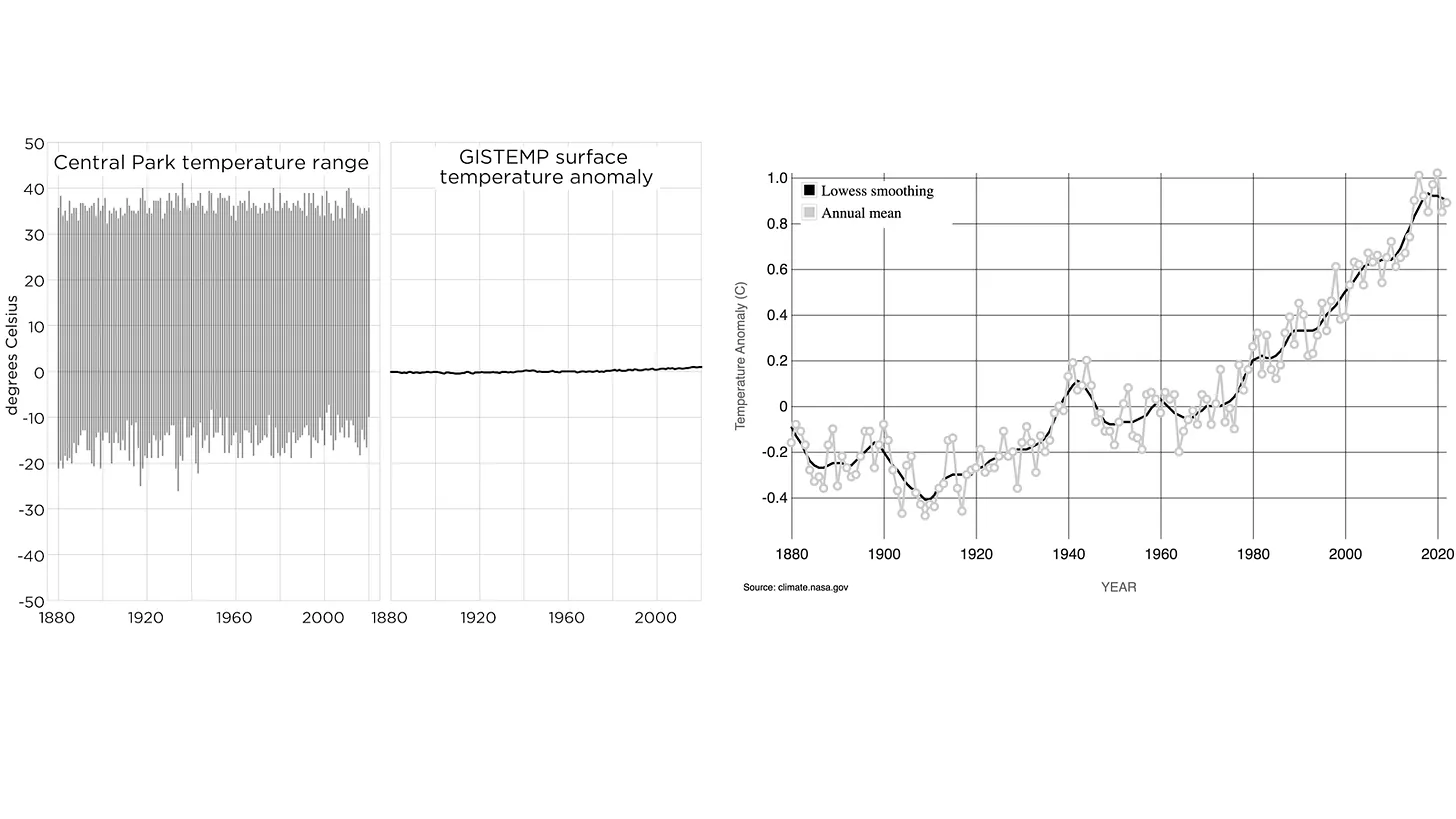
The “hottest on record” deception
We hear constant alarming-sounding claims that we are in or near “the hottest year on record.”
But given that records began at a cold time and we’re experiencing slow warming, of course any given year we can expect a new record. So what?10
We hear constant alarming-sounding claims that we are in or near “the hottest year on record.”
But given that records began at a cold time and we’re experiencing slow warming, of course any given year we can expect a new record. So what?10

Given our limited temperature records, alarming us about a “hottest year on record” during a slow warming period is like a doctor alarming a patient who gains one tenth of a pound of muscle that it’s his “heaviest year on record.”
The “hottest ever” deception
Climate catastrophists often absurdly equate a month or year being “the hottest on record”—which refers to the fewer than 200 years we have detailed temperature records—with being “the hottest ever.”
The “hottest ever” deception
Climate catastrophists often absurdly equate a month or year being “the hottest on record”—which refers to the fewer than 200 years we have detailed temperature records—with being “the hottest ever.”
Even though Earth was 25°F warmer for millions of years!11
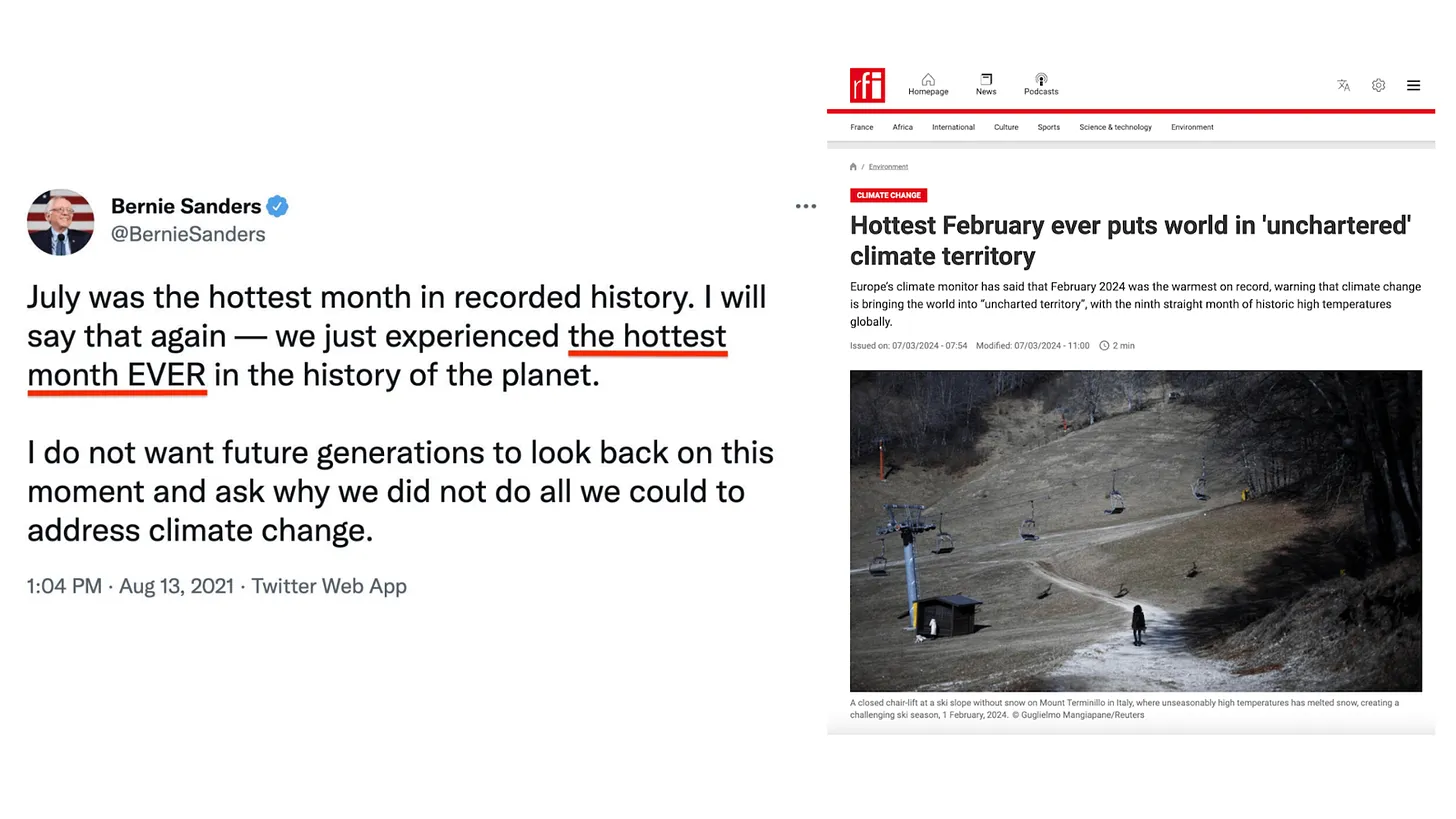
The “treating local extremes as global” deception
Given the slow pace of global warming, local temperature changes tend to be much larger than global ones. To scare us, catastrophists take the hottest local temperatures and portray them as global so we think everywhere is very hot.
For some true perspective on heat waves, look at the US Annual Heat Wave Index from the EPA, which says “Longer-term records show that heat waves in the 1930s remain the most severe in recorded U.S. history.”
Today's “reporting” would give you no indication this is the case.12
Given the slow pace of global warming, local temperature changes tend to be much larger than global ones. To scare us, catastrophists take the hottest local temperatures and portray them as global so we think everywhere is very hot.
For some true perspective on heat waves, look at the US Annual Heat Wave Index from the EPA, which says “Longer-term records show that heat waves in the 1930s remain the most severe in recorded U.S. history.”
Today's “reporting” would give you no indication this is the case.12
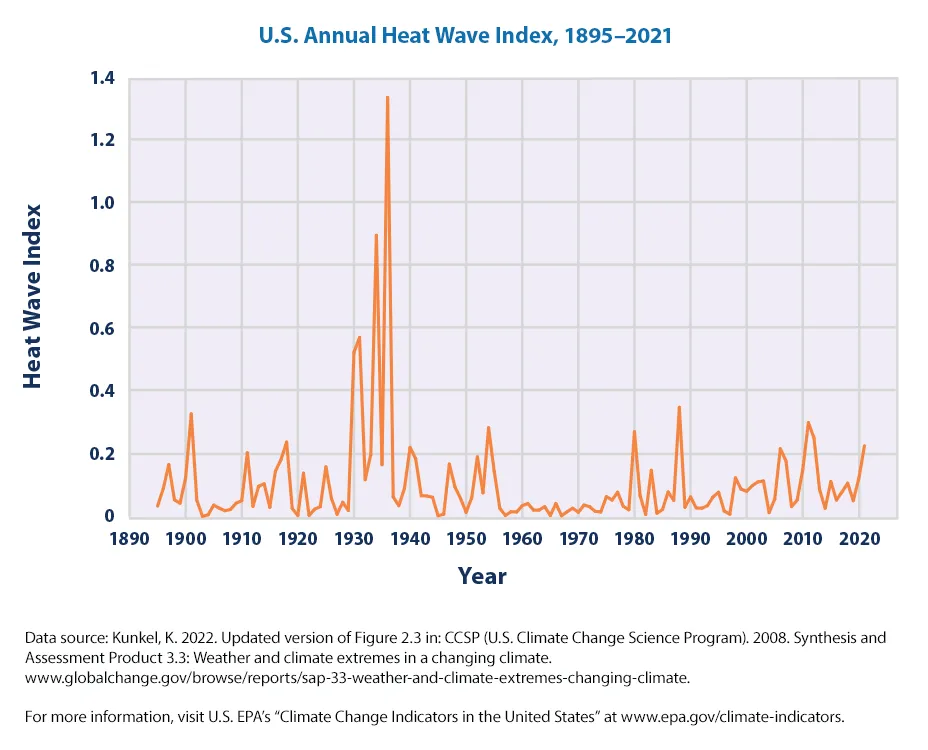
Warming so far has been slow and benign. But will future warming make the world unlivably hot?
No, given 2 facts almost universally acknowledged by climate scientists: 1) the diminishing warming impact of CO2, and 2) the concentration of warming in colder places.
The warming impact of CO2 diminishes (“logarithmically”) as it increases in concentration.
Every new molecule of CO2 we add to the atmosphere has less of a warming effect than the previous one. Warming will diminish as emissions increase—the only question is at what rate.13
No, given 2 facts almost universally acknowledged by climate scientists: 1) the diminishing warming impact of CO2, and 2) the concentration of warming in colder places.
The warming impact of CO2 diminishes (“logarithmically”) as it increases in concentration.
Every new molecule of CO2 we add to the atmosphere has less of a warming effect than the previous one. Warming will diminish as emissions increase—the only question is at what rate.13

Even the most wildly implausible “scenarios” from the anti-fossil-fuel IPCC include diminishing warming and a highly livable world with an increasing population.14
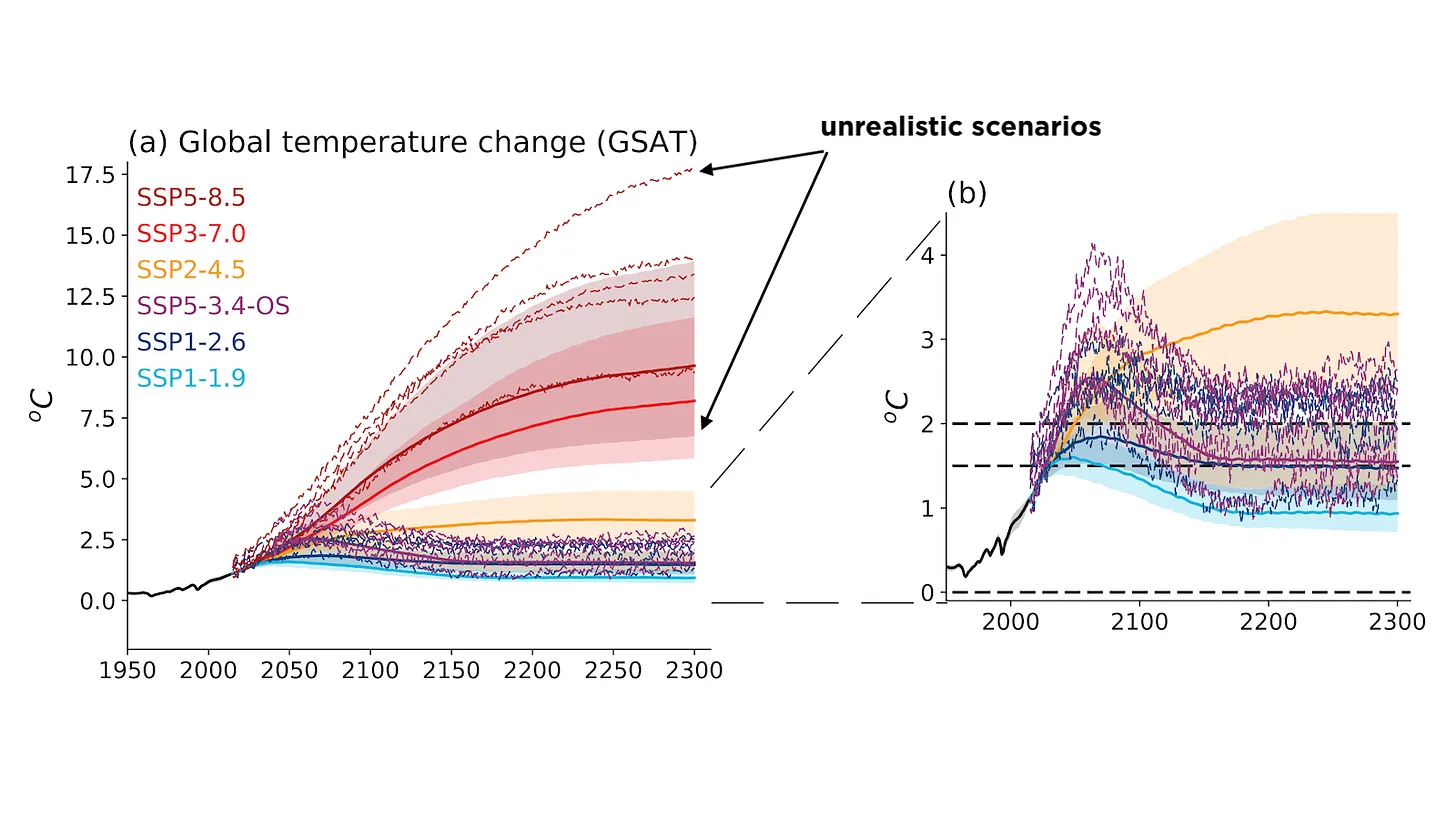
Climate warming is concentrated in colder areas of the world (such as the Arctic), during colder times of day, and during colder seasons.
This means that future warming will occur more in cold situations where it saves lives than in hot situations where it causes problems.15
This means that future warming will occur more in cold situations where it saves lives than in hot situations where it causes problems.15
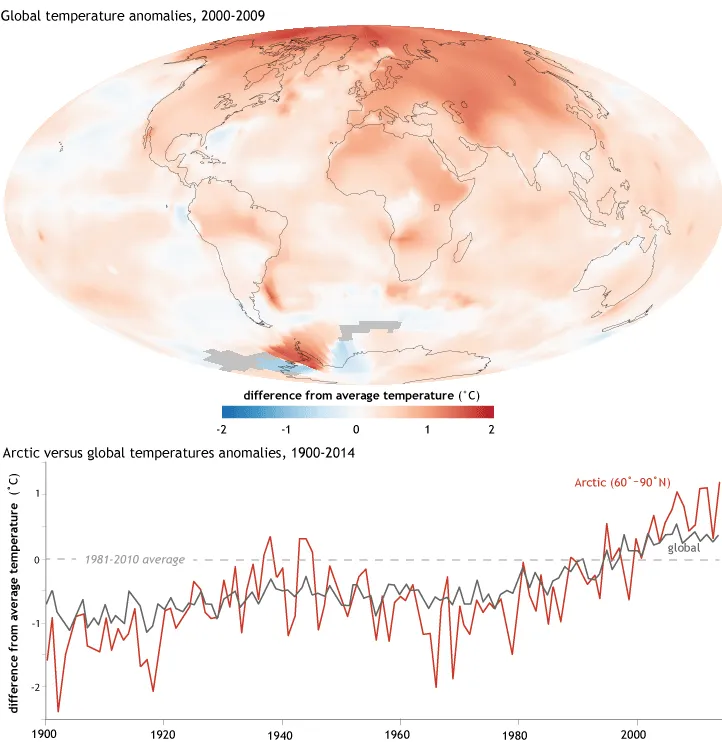
All reporting on the warming of the Earth should specify not only that humans are far more endangered by cold than by heat, but also that Earth is warming slowly—and less in warm places.
That virtually no reporting acknowledges this shows that much “reporting” is propaganda.
3. Fossil fuels make us safer from dangerous temperatures
Not only is the warming from fossil fuels’ CO2 emissions slow and in many ways beneficial, the uniquely cost-effective energy we get from fossil fuels makes us both safer from cold and heat.
That virtually no reporting acknowledges this shows that much “reporting” is propaganda.
3. Fossil fuels make us safer from dangerous temperatures
Not only is the warming from fossil fuels’ CO2 emissions slow and in many ways beneficial, the uniquely cost-effective energy we get from fossil fuels makes us both safer from cold and heat.
The portrayal of warming as a huge danger is based on the fallacy of only looking at the negative effects of something (in this case, warming), not the benefits.
Opponents of fossil fuels also commit this fallacy by ignoring the temperature-mastery benefits of fossil fuels.
The key to being protected from dangerous temperatures is to master them by producing different forms of temperature protection, such as: insulated buildings, heating, and air-conditioning. All of these things require energy—which means for most people they require fossil fuels.
Fossil fuels are the only source of low-cost, reliable energy that for the foreseeable future can provide energy to billions—in a world where 3 billion people still use less electricity than a typical American refrigerator.16
The developing world overwhelmingly uses fossil fuels because that is by far the lowest-cost way for them to get reliable energy. Unreliable solar and wind can’t come close. That’s why China and India have hundreds of new coal plants in development.17
“Studies” that claim future warming will make the world unlivably hot are denying temperature mastery. E.g., one study used by the EPA absurdly assumes that if a city like Chicago got as warm as some of today’s Southern cities, it won’t adapt and will just suffer mass heat death!18
It should be common sense for reporters and leaders that if we’re going to be looking at the temperature side-effects of fossil fuel use we also need to consider the enormous temperature mastery benefits that come with them.
But this common sense is almost never practiced.
Opponents of fossil fuels also commit this fallacy by ignoring the temperature-mastery benefits of fossil fuels.
The key to being protected from dangerous temperatures is to master them by producing different forms of temperature protection, such as: insulated buildings, heating, and air-conditioning. All of these things require energy—which means for most people they require fossil fuels.
Fossil fuels are the only source of low-cost, reliable energy that for the foreseeable future can provide energy to billions—in a world where 3 billion people still use less electricity than a typical American refrigerator.16
The developing world overwhelmingly uses fossil fuels because that is by far the lowest-cost way for them to get reliable energy. Unreliable solar and wind can’t come close. That’s why China and India have hundreds of new coal plants in development.17
“Studies” that claim future warming will make the world unlivably hot are denying temperature mastery. E.g., one study used by the EPA absurdly assumes that if a city like Chicago got as warm as some of today’s Southern cities, it won’t adapt and will just suffer mass heat death!18
It should be common sense for reporters and leaders that if we’re going to be looking at the temperature side-effects of fossil fuel use we also need to consider the enormous temperature mastery benefits that come with them.
But this common sense is almost never practiced.
4. Anti-fossil-fuel policies increase danger from cold and heat
The number one thing that will determine people’s safety from cold and heat for decades to come is the availability of cost-effective energy. Anti-fossil-fuel policies will increase both cold deaths and heat deaths.
On a planet where people die much more from cold than from heat, but both are major threats, the key to safety is to as affordable and plentiful energy as possible so as many as possible can afford heating and air-conditioning. For the foreseeable future, this means more fossil fuels.
Even though billions need fossil fuels to protect themselves from cold (above all) and heat, today’s media and leaders pretend that heat is the only problem and the solution is to follow anti-fossil-fuel policies that will supposedly cool the Earth.
This is breathtakingly dishonest.
Not only do anti-fossil-fuel policies deprive people of the energy they need to protect themselves from both cold and heat, these policies cannot cool the Earth for at least several decades, and only then if the whole world, including China, follows them absolutely.
Even if 100% net-zero energy is just decades away (absurd) that won’t even have a tiny cooling impact until emissions are zero (or negative) and today’s warming energy dissipates.
To portray anti-fossil-fuel policies as cooling in any way anytime soon is dishonest.19
The number one thing that will determine people’s safety from cold and heat for decades to come is the availability of cost-effective energy. Anti-fossil-fuel policies will increase both cold deaths and heat deaths.
On a planet where people die much more from cold than from heat, but both are major threats, the key to safety is to as affordable and plentiful energy as possible so as many as possible can afford heating and air-conditioning. For the foreseeable future, this means more fossil fuels.
Even though billions need fossil fuels to protect themselves from cold (above all) and heat, today’s media and leaders pretend that heat is the only problem and the solution is to follow anti-fossil-fuel policies that will supposedly cool the Earth.
This is breathtakingly dishonest.
Not only do anti-fossil-fuel policies deprive people of the energy they need to protect themselves from both cold and heat, these policies cannot cool the Earth for at least several decades, and only then if the whole world, including China, follows them absolutely.
Even if 100% net-zero energy is just decades away (absurd) that won’t even have a tiny cooling impact until emissions are zero (or negative) and today’s warming energy dissipates.
To portray anti-fossil-fuel policies as cooling in any way anytime soon is dishonest.19

Dangerously cold and hot temperatures are by far the most problematic for poor people. What they need is more fossil fuel energy for air-conditioning and heating now, not a climate and energy policy that prevents real future low-emission solutions and makes energy expensive now.
Anyone offering advice on how to deal with hot temperatures is obligated to give advice that will actually help human beings for the foreseeable future. Pretending that supporting anti-fossil-fuel policies will help people anytime soon by cooling the Earth is a lie.
Not only is it a lie that anti-fossil-fuel policies will protect people anytime soon by cooling the Earth, it is a deadly lie—because in practice it means preventing people from acquiring the air-conditioning they need to deal with warm temperatures today and in the future.
The only moral and practical way to reduce CO2 emissions—a global phenomenon—is innovation that makes low-carbon energy globally cost-competitive. So long as fossil fuels are the most cost-competitive option, especially in developing nations, they will rightly choose to emit CO2.
Reducing CO2 emissions in a humane and practical way means focusing on liberating alternatives—especially the most potent, nuclear—to try to truly outcompete fossil fuels in the future.
Summary: Unusually warm temperatures, a temporary anomaly, are no cause for alarm and certainly no cause for adopting anti-fossil-fuel policies.
To protect ourselves both from heat and the far bigger problem of cold, we need to use more fossil fuels for the foreseeable future.
Steffen Henne contributed to this piece.
Anyone offering advice on how to deal with hot temperatures is obligated to give advice that will actually help human beings for the foreseeable future. Pretending that supporting anti-fossil-fuel policies will help people anytime soon by cooling the Earth is a lie.
Not only is it a lie that anti-fossil-fuel policies will protect people anytime soon by cooling the Earth, it is a deadly lie—because in practice it means preventing people from acquiring the air-conditioning they need to deal with warm temperatures today and in the future.
The only moral and practical way to reduce CO2 emissions—a global phenomenon—is innovation that makes low-carbon energy globally cost-competitive. So long as fossil fuels are the most cost-competitive option, especially in developing nations, they will rightly choose to emit CO2.
Reducing CO2 emissions in a humane and practical way means focusing on liberating alternatives—especially the most potent, nuclear—to try to truly outcompete fossil fuels in the future.
Summary: Unusually warm temperatures, a temporary anomaly, are no cause for alarm and certainly no cause for adopting anti-fossil-fuel policies.
To protect ourselves both from heat and the far bigger problem of cold, we need to use more fossil fuels for the foreseeable future.
Steffen Henne contributed to this piece.

